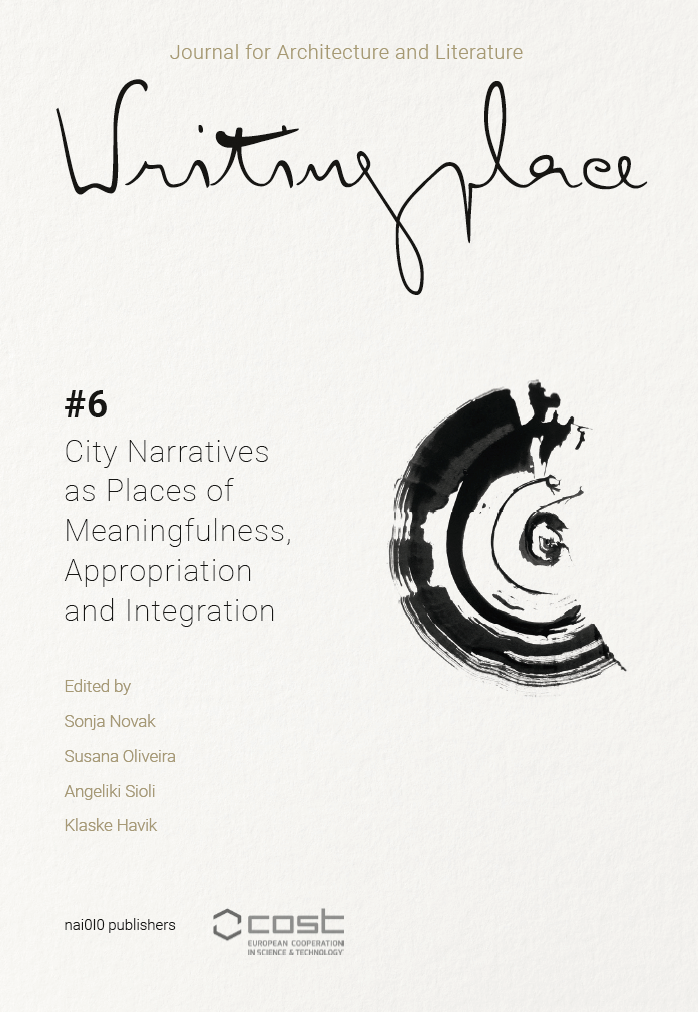The Belly of Naples and Displaced Meanings, City-as-Body and City-as-Theatre in Commentaries on the Old Town Risanamento
Deconstructing the Stereotype of the Picturesque
DOI:
https://doi.org/10.7480/writingplace.6.6353Abstract
This article considers the formation of stereotypical images associated with the picturesque of the South, analysing the case of Naples. The text examines selected urban images reported before and after the late-nineteenth-century Risanamento period of dramatic renovations of the old town, with a focus on city-as-body and city-as-theatre tropes. The inevitable departure is Il Ventre di Napoli (1884-1906, The belly of Naples) by Matilde Serao. We will see how Serao tackles all contradictions of a built environment teeming with life. We have then connected excerpts from foreign travellers, again before and after the Risanamento, to the pleasures (or sickness) of flesh and theatricality. These displaced meanings parallel many descriptions by writers that travelled to Naples: Charles Dickens and the pantomime, Jean-Paul Sartre’s delirium of flesh and rotten food, Benjamin and the city-
References
Franco Cassano, Il pensiero meridiano (Roma-Bari, 1996) and Franco Cassano, Tre modi di vedere il Sud (Bologna, 2009). Il pensiero meridiano is available in an English edition published by Fordham University Press in 2012.
Ruth Glynn, ‘Porosity and Its Discontents: Approaching Naples in Critical Theory’, Cultural Critique 107 (2020), 63-98.
Iain Chambers, Mediterranean Crossings: The Politics of an Interrupted Modernity (Durham, NC, 2008).
Henri Lefebvre, The Production of Space, translated by Donald Nicholson-Smith (Oxford and Cambridge, 1991).
Giuseppe Galasso, L’altra Europa: Per un’antropologia storica del Mezzogiorno d’Italia (Milan, 1982).
Massimo Cacciari, ‘Non potete massacrarmi Napoli!’, in: Claudio Velardi (ed.), La città porosa: Conversazioni su Napoli (Naples, 1992), 157-190.
Glynn, ‘Porosity and Its Discontents’, op. cit. (note 2).
John Dickie, Darkest Italy: The Nation and Stereotypes of the Mezzogiorno, 1860-1900 (New York, 1999).
Lila Leontidou, ‘Alternatives to Modernism in (Southern) Urban Theory: Exploring in-between Spaces’, International Journal of Urban and Regional Research 20/2 (1996), 180.
On the common ground shared by tourism and anthropology, see: Dennison Nash and Valene L. Smith, ‘Anthropology and Tourism’, Annals of Tourism Research 18/1 (1991), 12-25; and Tom Selwyn, ‘Anthropology and Tourism’, Tourism Management 11/1 (1990), 68-69.
Melissa Calaresu, ‘From the Street to Stereotype: Urban Space, Travel and the Picturesque in Late Eighteenth-Century Naples’, Italian Studies 62/2 (2007), 189-203.
Jean-Paul Sartre, Spaesamento: Napoli E Capri (Naples, 2000). Originally published in OEuvres romanesques in 1982 under the title ‘Dépaysement’.
Giuseppe Sanarelli, Il colera: epidemiologia, patologia, batteriologia, terapia e profilassi (Milan, 1931).
Elena Manzo, ‘Il “Risanamento” di Napoli. Dal progetto urbano alla scala architettonica’, Atti e Rassegna Tecnica della Società degli Ingegneri e degli Architetti in Torino 72/1 (2018), 113-122.
Daniela Lepore, ‘Il Centro Storico Di Napoli: Vecchi Propositi E Nuovi Progetti’, 53 Meridiana 5 (1989), 129-142.
Ann-Louise Shapiro, ‘Housing Reform in Paris: Social Space and Social Control’, French Historical Studies 12/4 (1982), 486-507.
Matilde Serao, Il Ventre Di Napoli: Venti Anni Fa (Naples, 1906), 101-102.
Leonardo Benevolo, The Origins of Modern Town Planning, translated by Judith Landry (London, 1967).
Darby Tench, ‘Gutting the Belly of Naples: Metaphor, Metonymy and the Auscultatory Imperative in Serao’s City of “Pietà”’, Annali d’Italianistica 7 (1989), 288-289.
Serao, Il Ventre Di Napoli, op. cit. (note 18).
Manzo, ‘Il “Risanamento” di Napoli’, op. cit. (note 15).
Maria Gabriella Caponi-Doherty, ‘Charles Dickens and the Italian Risorgimento’, Dickens Quarterly 13/3 (1996), 151-163.
Charles Dickens, Pictures from Italy (London, 1846), 240.
Rosemary Sweet, Gerrit Verhoeven and Sarah Goldsmith (eds.), Beyond the Grand Tour: Northern Metropolises and Early Modern Travel Behaviour (London, 2017).
Stendhal, Rome, Naples Et Florence (Paris, 1817), 61. Translated by Richard Coe as ‘one of the principal goals of all my journey, the busiest, most joyous thoroughfare in the entire universe’, in: Stendhal, Rome, Naples and Florence, translated by Richard N. Coe (London, 1959), 350.
Fragment of a story published for the first time as ‘Nourritures’, in: Verve, November 15, 1938. In Italy, it was published with the title ‘I vicoli di Napoli’
(The alleys of Naples) in Lotta Continua, April 17, 1980, 20. Then it was incorporated in Sartre, Spaesamento, op. cit. (note 13).
Michel Rybalka and Michel Contat (eds.), The Writings of Jean-Paul Sartre, vol. 2, Studies in Phenomenology & Existential Philosophy (Evanston, 1974), 60.
Tobias Haberkorn, ‘Se Sentir Napolitain: Voir, Vivre, Écrire La Ville Avec Goethe, Sartre, Malaparte Et Saviano’, Eurostudia 8/1-2 (2012), 149-169.
Rybalka and Contat, The Writings of Jean-Paul Sartre, op. cit. (note 37), 62.
Natalia Rita Giannini, Naples: The Mother City (Boca Raton, 2003).
Giuliana Bruno, Atlas of Emotion (London, 2002), §11.
Irwin Chusid, ‘John Turturro’s Passione Stays True to the Music’, Filmcomment (September/October 2011), 16.
Walter Benjamin, Reflections: Essays, Aphorisms, Autobiographical Writings
(New York, 1986), 165-166.
Steven Holl, Parallax (New York, 2000).
Daniele Dottorini, ‘Rileggere Benjamin: la forma della città, la doppia immagine della modernità’, Cahiers d’études romanes 19 (2008), 153-166.
Glynn, ‘Porosity and Its Discontents’, op. cit. (note 2).
Downloads
Published
How to Cite
Issue
Section
License
Copyright (c) 2022 Giuseppe Resta

This work is licensed under a Creative Commons Attribution 4.0 International License.



